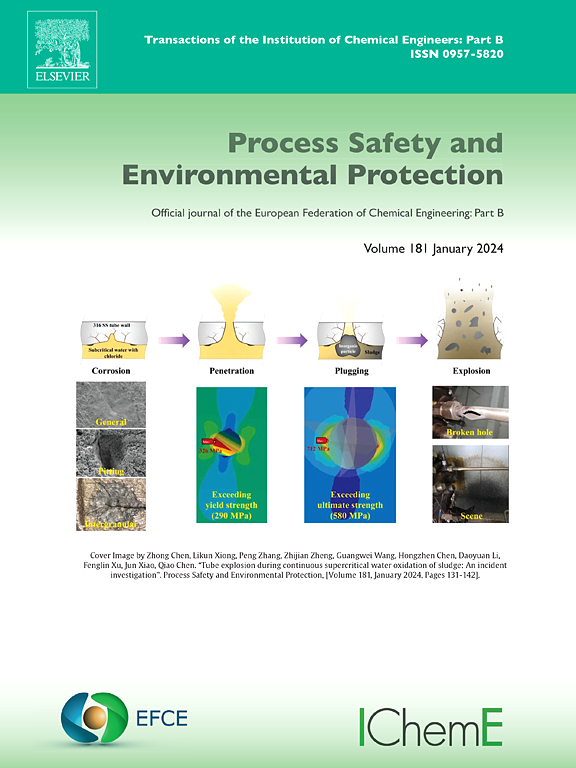Microwave-facilitated biodiesel production through rGO-based multifunctional metal oxide nanocatalysts to improve engine characteristics
IF 7.8
2区 环境科学与生态学
Q1 ENGINEERING, CHEMICAL
引用次数: 0
Abstract
In this study, an improved bifunctional rGO/CaO/NiO (rCN) nanocomposite was designed and used to synthesize biodiesel (BD) from waste edible oil (WEO) via a microwave-aided method. Detailed structural characterisation of the catalyst indicated a large precise surface area and excellent surface characteristics. Response surface methodology (RSM) based 34 factorial central composite design (CCD) was used to otimize the biodiesel production parameters. The optimal reaction conditions, which included a molar ratio of 11.1:1, microwave treatment for 7.5 min, a catalyst dosage of 3 wt%, and an agitation alacrity of 700 rpm, resulted in a significant BD yield of 97.46 %. The catalyst has shown outstanding stability and performed well by proving its reusability till seventh sets to produce high yield of BD. The kinetic analysis showed that the conversion of WEO to BD had 30.91 kJ/mol of reaction initiation energy and an exponential influence of 2.3 × 10⁴ min⁻¹ . It was discovered that the physical characteristics of the biodiesel obtained from WEO met ASTM D6751 requirements. Further, the model of the engine is DIESEL 3LD510 an make is Lombardini is used to test the performance and emissions of biodiesel blends (B0, B10, B20 and B30) in various loading. At maximum load, the B10, B20, and B30 blends showed a decrease in BSFC by 2.19 %, 5.43 % and 9.21 % respectively, while BTE improved by 1.91 %, 2.52 % and 4.1 % compared to the B0. Additionally, the inclusion of biodiesel in the B30 mixture led to a reduction in CO, HC, and NOₓ releases by 40.02 %, 36.11 %, and 5.68 %, respectively, relative to the base fuel B0. Overall, the rCN nanocatalyst stands out as an excellent option for the production of high yield of BD due to its shorter time of response and unparalleled reusability.
微波促进生物柴油生产通过rgo为基础的多功能金属氧化物纳米催化剂,以提高发动机的特性
本研究设计了一种改进的双功能氧化石墨烯/CaO/NiO (rCN)纳米复合材料,并利用微波辅助方法从废食用油(WEO)中合成生物柴油(BD)。详细的结构表征表明,该催化剂具有精确的大表面积和优异的表面特性。采用基于34因子中心组合设计(CCD)的响应面法(RSM)对生物柴油生产工艺参数进行优化。最佳反应条件为:摩尔比为11.1:1,微波处理时间为7.5 min,催化剂用量为3 wt%,搅拌速度为700 rpm,收率为97.46 %。该催化剂表现出优异的稳定性,并证明其可重复使用至第七组,以产生高收率的BD。动力学分析表明,WEO转化为BD的反应引发能为30.91 kJ/mol,指数影响为2.3 × 10⁴min⁻¹ 。研究发现,从WEO获得的生物柴油的物理特性符合ASTM D6751的要求。此外,该发动机的型号为DIESEL 3LD510,型号为Lombardini,用于测试各种负载下生物柴油混合物(B0, B10, B20和B30)的性能和排放。在最大负荷下,B10、B20和B30的BSFC分别比B0降低了2.19 %、5.43 %和9.21 %,BTE分别比B0提高了1.91 %、2.52 %和4.1 %。此外,与基础燃料B0相比,在B30混合物中加入生物柴油导致CO、HC和NOₓ的排放量分别减少了40.02 %、36.11 %和5.68 %。总的来说,rCN纳米催化剂因其响应时间短和无与伦比的可重复使用性而成为生产高产量双酚a的绝佳选择。
本文章由计算机程序翻译,如有差异,请以英文原文为准。
求助全文
约1分钟内获得全文
求助全文
来源期刊

Process Safety and Environmental Protection
环境科学-工程:化工
CiteScore
11.40
自引率
15.40%
发文量
929
审稿时长
8.0 months
期刊介绍:
The Process Safety and Environmental Protection (PSEP) journal is a leading international publication that focuses on the publication of high-quality, original research papers in the field of engineering, specifically those related to the safety of industrial processes and environmental protection. The journal encourages submissions that present new developments in safety and environmental aspects, particularly those that show how research findings can be applied in process engineering design and practice.
PSEP is particularly interested in research that brings fresh perspectives to established engineering principles, identifies unsolved problems, or suggests directions for future research. The journal also values contributions that push the boundaries of traditional engineering and welcomes multidisciplinary papers.
PSEP's articles are abstracted and indexed by a range of databases and services, which helps to ensure that the journal's research is accessible and recognized in the academic and professional communities. These databases include ANTE, Chemical Abstracts, Chemical Hazards in Industry, Current Contents, Elsevier Engineering Information database, Pascal Francis, Web of Science, Scopus, Engineering Information Database EnCompass LIT (Elsevier), and INSPEC. This wide coverage facilitates the dissemination of the journal's content to a global audience interested in process safety and environmental engineering.
 求助内容:
求助内容: 应助结果提醒方式:
应助结果提醒方式:


